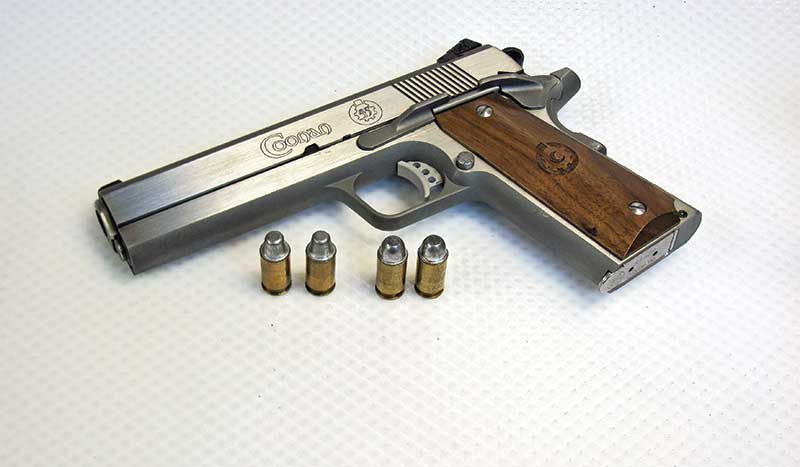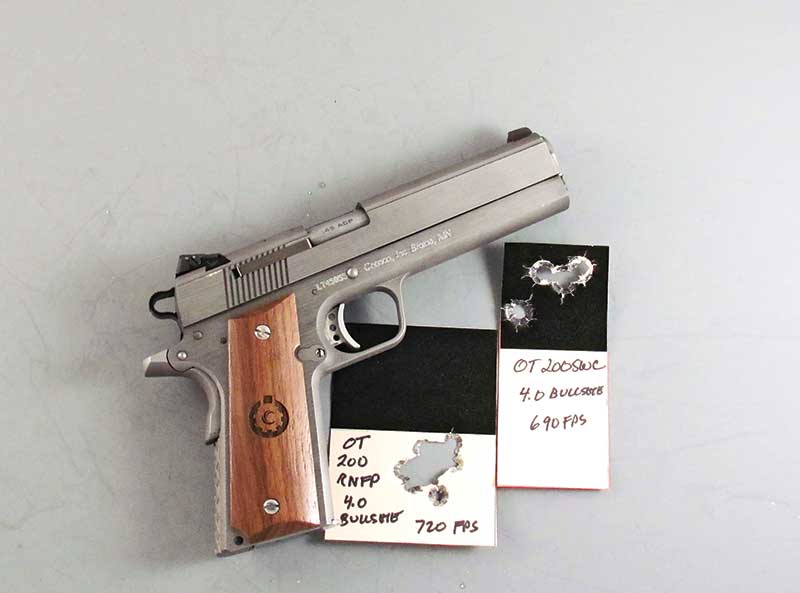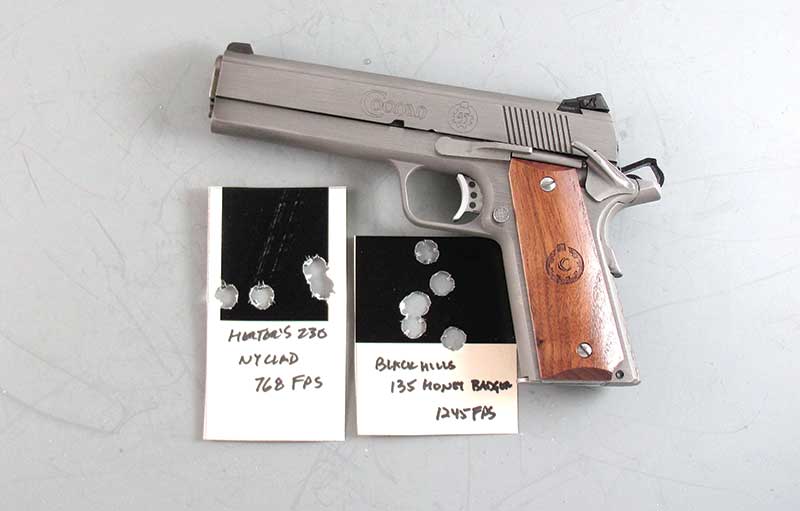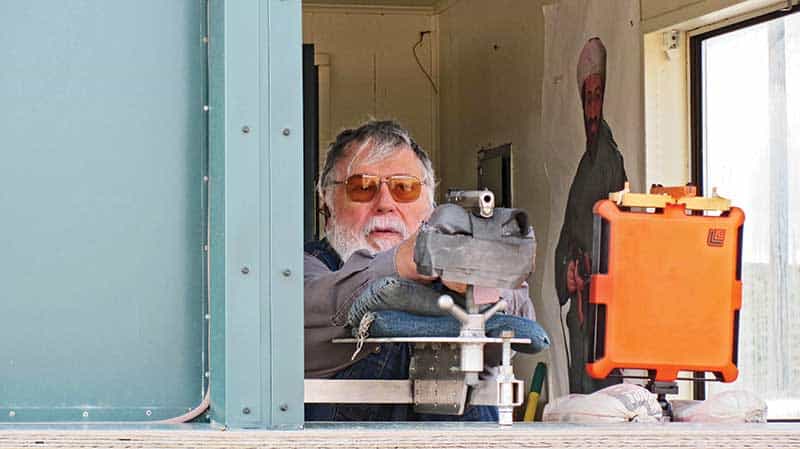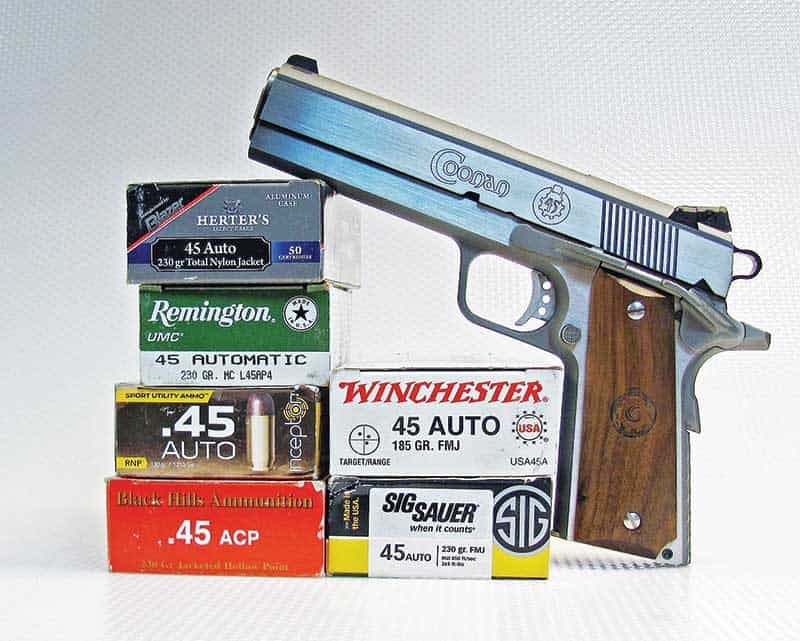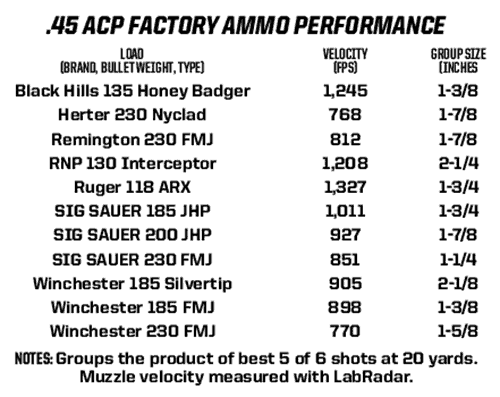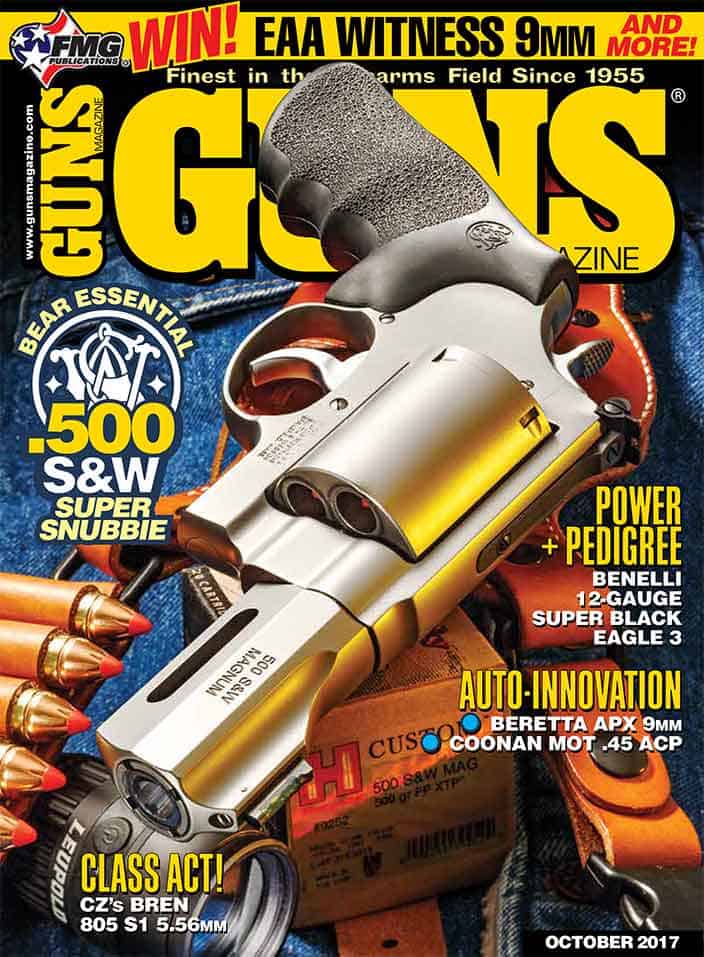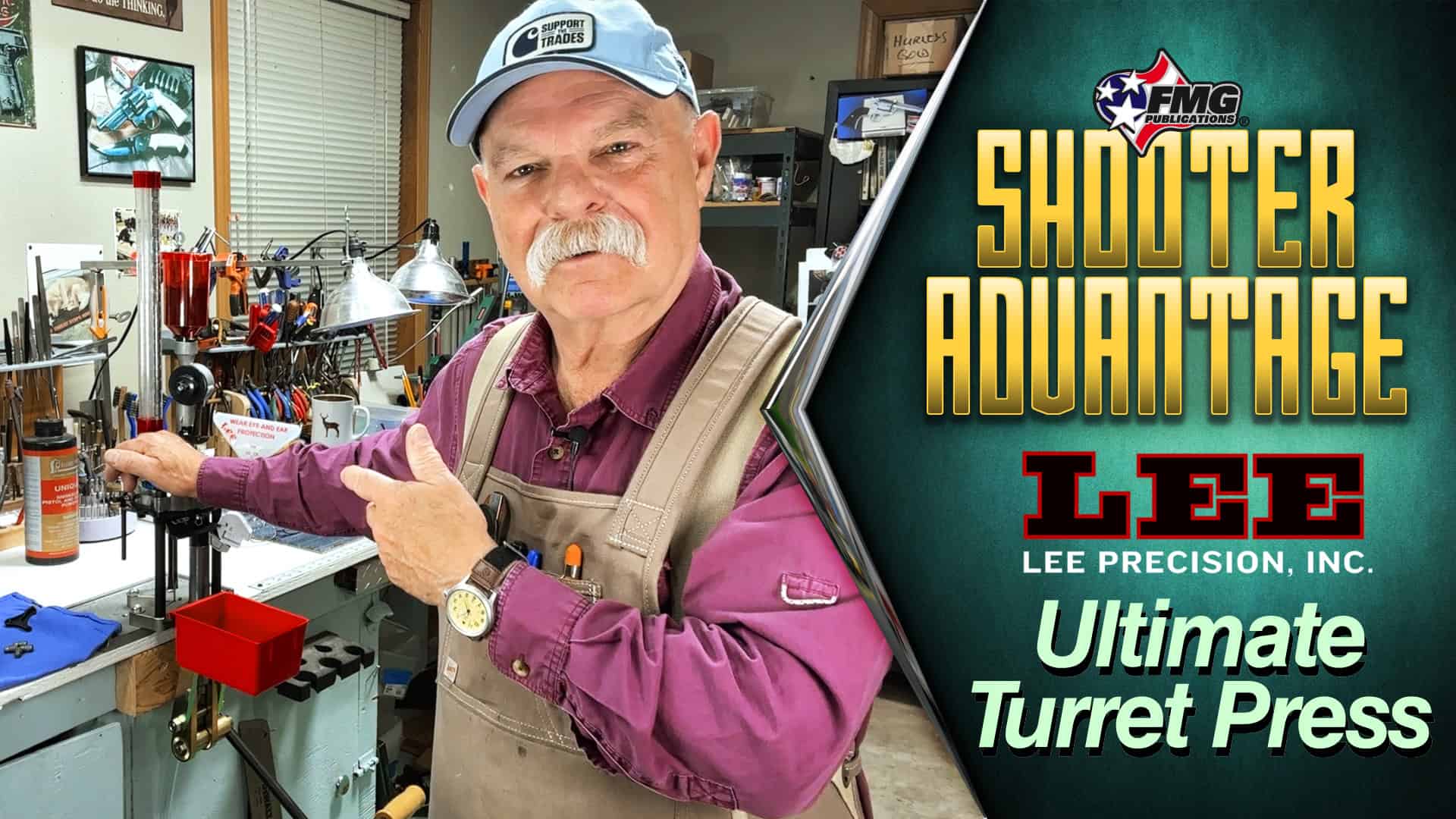Coonan .45 MOT
This Sweet-Running “Linkless” 1911 Has
Innovative Touches Above And
Beyond Your Basic Browning Template
At the beginning of the 1990’s—as semi-auto pistols began to take center stage—we saw the advent of three .357 Magnum specimens. Two of these were exceptionally large handguns—namely the now-defunct Grizzly (basically an enlarged 1911) and Israel’s Desert Eagle.
Dan Coonan, who designed the pistol which bears his name, went a different way to come up with a truly portable, packable .357 Magnum semi-auto. Today, he offers two basic 1911-style and sized .357’s—the full-size Coonan Classic and the Commander-style Compact. Both versions are offered in several variations and finishes. Coonan has now taken the next step with the .45 MOT.
When I started shooting, you could have any .45 ACP pistol you wanted just as long as it was a surplus Government Model 1911. This was in the mid-1950’s and I rarely, if ever, saw a commercial version. Custom gunsmiths were just really getting started accurizing the 1911 and fitting them with adjustable sights. Sometimes, progress can be wonderful and this is certainly the case when it comes to the 1911.
It would be a daunting task to try to list everyone who has manufactured a .45 ACP 1911 in my shooting lifetime. We have an endless line of choices from basic no-frills guns to high-dollar custom ones which cost more than my first house. All of this is good for shooters. Competition between manufacturers means 1911’s different from the ordinary will always be available. This might include extreme hand-fitting to a difference in the basic design.
With the Coonan line, we see basic John Browning with ideas borrowed from both the 1911 and Hi-Power. Due to the length of the .357 cartridge, the grip on the .357 Coonan is necessarily a different size than the standard 1911, but with the .45 chambering, we get back to the more familiar 1911 grip size. Looking at the Coonan .45 for the first time, it’s easy to conclude this is indeed a standard 1911. However, Coonan points out three distinctive features not normally found on a standard 1911.
First is an external extractor, something which gunmakers, gunsmiths, and shooters have been arguing over for more than a century. Coonan uses it to improve reliability of both cycling and ejection. It certainly works as I had no problems whatsoever on either score with factory and handloaded ammo featuring different bullet configurations. Instead of a leaf spring, this external extractor is powered by a longer-lasting coil spring, which also provides for stronger extraction.
The other two qualities we find in the Coonan .45 are rarely—if ever— seen in other production 1911’s. The Coonan 1911 .45’s trigger is on a pivot. The factory claims this results in a more consistent trigger pull. Factory specs call for a trigger pull of 4 to 5 pounds, however, as it came from the factory, the pull on my test sample registers at 7-1/2 pounds on my Brownells’ Trigger Pull Gauge, and for my everyday use I would prefer to have this figure cut in half. The trigger itself is wide and smooth, as I like, and also skeletonized with three holes.
Look Ma, No Link!
The most radical difference with the Coonan .45 compared to other models is the fact the 5-inch barrel is linkless! Yes, the familiar movable link on the back of the barrel which is used to lock it into the slide/frame is gone and replaced by a solidly attached under-barrel groove. The purpose of this change in design is for increasing accuracy, while at the same time reducing feeding problems. The lockup also remains more consistent for a longer period of time than with the standard link. Again there was no problem whatsoever with feeding, no manner which ammunition I tried and accuracy was excellent (more on this later). Takedown, in spite of the change in barrel lock up, is the same as any 1911.
Taking an overall look at the Coonan .45 we see a classic looking 1911 pistol of all stainless steel construction. The sights are fully adjustable, 3-dot Novak-type with the rear sight set deep in the slide. This is a far cry from the way adjustables were set on the top of the slide in the early days of accurizing.
Looking at the rear sight from the back we see an excellent design—sloped to the front with the rear face serrated and a square notch with a white dot on each side. This mates up with a dovetailed front sight which slopes to the front with a white dot on its face. In short, the sight setup is excellent.
Moving on to the slide we find slanted cocking serrations below the rear sight and external extractor. The hammer is Commander-style. Both the thumb safety and the slide lock are of the extended variety and easily accessible. The beavertail grip safety protects the back of your hand from being bitten and the memory bump helps you depress the grip safety fully.
The flat mainspring housing is checkered for a firm grip. The grip panels themselves are smooth walnut with the Coonan logo. Finally, the Coonan .45 MOT comes with two 7-round magazines in a padded black zippered bag.
I test-fired the Coonan .45 MOT with three handloads using cast bullets and 11 factory loads. Both of my standard practice loads using 4.0 grains of Bullseye performed exceptionally well. Those loads assembled with Oregon Trails 200-grain RNFP hardcast bullets proved the most accurate, resulting in a 1-inch group for 5 shots at 20 yards (muzzle velocity: 720 fps). Switching to their 200-grain SWC (basically the same design as the H&G 200SWC or the RCBS 45-201), muzzle velocity was right at the same level with a group of 1-3/8 inches.
When I switched to factory loads, the most accurate proved to be SIG SAUER’s 230-grain FMJ at 850 fps (1-1/4 inches) and Winchester’s 185-grain FMJ at 900 fps (1-3/8 inches). This range test was also my first time to try several new types of ammo. We’ve all noted the advent of a new style of copper bullet resembling a Phillips screwdriver bit. From Ruger it is known as the ARX, weighs 118 grains and clocks out at 1,325 fps. This one grouped at 1-3/4 inches for me. Black Hills’ version is the 135-grain Honey Badger with a muzzle velocity of 1,245 fps. This one came in at 1-3/8 inches. Even with their lighter weight and higher velocity, these two loads still shoot close to point of aim. With the adjustable sights of the Coonan they can be dialed in exactly. Both are designed for self-defense, providing penetration as well as a large wound cavity. I also tried the new RNP Interceptor .45 loading. This is a 130-grain bullet made of powdered metal and is designed to disintegrate and turn back to powder upon hitting a hard surface. This makes them safe for steel plates at close ranges. Muzzle velocity, incidentally, is over 1,200 fps.
As you may have noticed this particular Coonan’s Model name is MOT. I tried to puzzle out what in the world “MOT” stood for by looking at their website as well as the owner’s manual. Finally I contacted David Dietz who is the director of marketing at Coonan and asked him.
He replied, “As you may be aware, we are a very small company and quite informal as a result. There is a 120-pound German Shepherd roaming the front administration office area and he belongs to Greg and Connie White who are the CEO and office manager. This dog is a cuddly sweetheart to all he knows, but when someone comes to the door he doesn’t recognize, let’s just say his bark goes down two octaves and his volume increases several decibels thus achieving the true guard-dog effect. When working on the new pistol, we realized we needed a model designation for all our new standard 1911-sized frames. Of course it needed to be another TLA (not Texas Longhorn Arms, but a Three Letter Acronym) as is the convention in our industry. Well, we all wracked our brains attempting to come up with something either very clever or very descriptive or, ideally, both. Well, we gave up on this idea. The German Shepherd’s name is Motley and so was born the new platform name, the Coonan MOT. Now in .45 ACP!”
You gotta love a company with a sense of humor!
Gold Standard
In addition to trying some new-style factory ammunition, I also had the occasion to try Hurley’s Gold—a new composite firearms lubricant. This is a high-temp lube—good up to 1,000 degrees F—with a blend of synthetic oil, mineral oil, grease additives and long-lasting dry lubricant. For the Coonan .45 MOT I used to drop on each rail and then brushed some on both ends of the barrel. It seems to work very well and I will be using it in the future, especially on semi-autos to aid in keeping them running perfectly.
Hurley’s Gold
P.O. Box 130276
Carlsbad CA 92013
(623) 202-4433
www.hurleysgold.com
Alliant Powder
P.O. Box 856
Lewiston, ID 83501
(800) 379-1732
www.alliantpowder.com
Black Hills Ammunition
P.O. Box 3090
Rapid City, SD 57709
(605) 348-5150
www.blackhills.com
Oregon Trail Bullets
P.O. Box 529
Baker City, OR 97814
(800) 811-0548
www.laser-cast.com
PolyCase/RNP
41 Artley Rd.
Savannah, GA 31408
www.polycaseammo.com
SIG SAUER
72 Pease Blvd.
Newington, NH 03801
(603) 418-8102
www.sigsauer.com
Starline Brass
1300 West Henry
Sedalia, MO 65301
(660) 827-6640
www.starlinebrass.com
Sturm, Ruger & Co.
200 Ruger Rd
Prescott, AZ 86301
(928) 7786555
www.ruger-firearms.com
